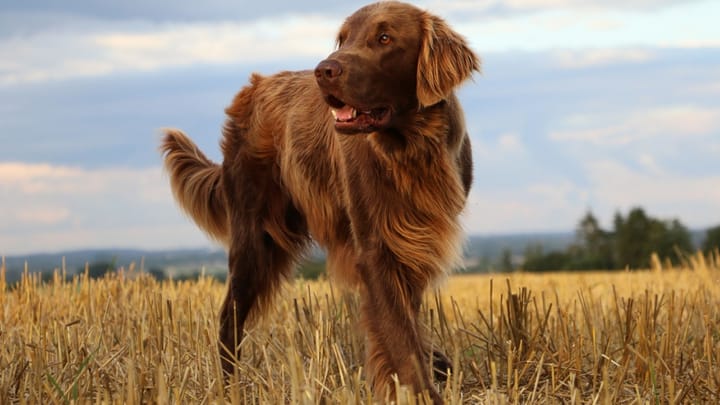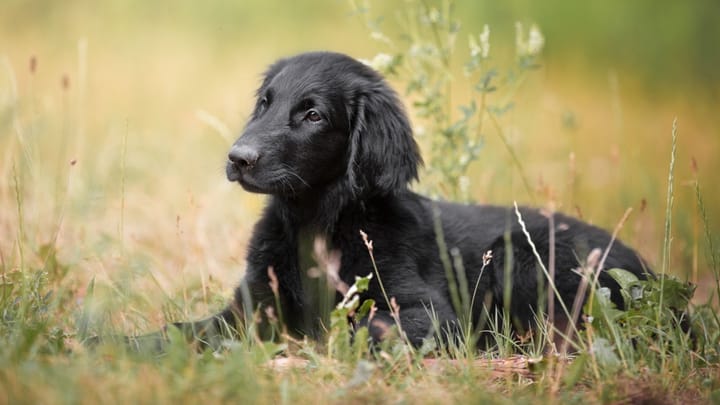Flat-Coated Retriever
Other names : Flatcoat, Flattie


The Flat-coated Retriever is an outgoing and affectionate dog belonging to the Retriever Group. Originally bred in Victorian England as a gundog it became the popular choice of companion for gamekeepers of the large sprawling estates of the Upper Class. A Retriever by name and nature, this agile dog moves powerfully and without lumber. Although still used by some huntsmen and women for retrieval of bagged game the Flattie is more widely known to be an amiable addition to the modern family home.
|
Life expectancy |
The Flat-Coated Retriever has a life expectancy of between 8 and 10 years |
|
Temperament |
|
|
Size |
Medium
|
|
Adult size |
Female
Between 22 and 23 in
Male
Between 23 and 24 in
|
|
Adult weight |
Female
Between 55 and 71 lb
Male
Between 60 and 79 lb
|
|
Coat colour
Black, liver (dark brown); solid colour throughout. |
Black Brown |
|
Type of coat
The hair length is medium. A flat, dense coat of fine texture and shine. The legs and tail are especially well-furnished. |
Short |
|
Eye colour
Dark brown or hazel. |
Brown
|
|
Purchase price |
The Flat-Coated Retriever costs between £760 and £900 |
This dog is eager and quick to learn but will do so at its own pace and only if the reward for learning is worthy. Keep training sessions short and varied otherwise the attention of the dog will be lost. If the Flattie thinks it can get the better of its owner it will.
More details about the Flat-Coated Retriever
Flat-Coated Retriever: Origins and history
The ancestor of the Flat-coat breed was created in the middle of the 1800s; successive inbreeding with the North American water dog, native collies and the Newfoundland dog is thought to have given rise to the Flat-coated Retriever familiar to us today. The pedigree was finally established in 1880. The hereditary of this dog is believed to be the cause of its predisposition to the cancers listed above.
Physical characteristics of the Flat-Coated Retriever
The muzzle of the Flattie is strong and muscular; the top-line from the point of its nose to the back of its head is relatively smooth. From the nape of the dog’s head the top-line then descends gracefully, strong and straight until ending at the croup above the tail. The tail itself is well-feathered and moderately long, held almost horizontally from the set. Ears are relatively small and hang close to the side of the head. Overall, the body of the Flattie should be light and agile.
FCI classification of the Flat-Coated Retriever
-
Group 8 - Retrievers - Flushing Dogs - Water Dogs
-
Section 1 : Retrievers
Flat-Coated Retriever: Characteristics
Flat-Coated Retriever: Behaviour
Training a Flat-Coated Retriever
The Flattie’s extended puppyhood can cause some problems when it comes to training. As well as being a wilful dog, it will test human boundaries and patience, and lose attention very quickly. Training should be consistent and forthright but not harsh: the dog’s behaviour will only worsen if it is shouted at. Successful training of a Flat-coat results in the dog’s exceptionally obedient behaviour.
Flat-Coated Retriever: Lifestyle
Breed compatibility Flat-Coated Retriever
Flat-Coated Retriever: Purchase price
The price for a Flat-Coated Retriever can vary according to its origin, gender and age. For a dog registered at the Kennel Club, they will cost on average £900.
Concerning your average monthly budget to satisfy your Flat-Coated Retriever’s needs, it will vary between £120 and £175 per month.
Flat-Coated Retriever: Shedding
Average
Flat-coated Retrievers shed a fair amount. On the lead up to summer the ‘blow coat’ leads to an increase of moult.
Flat-Coated Retriever: Grooming
Brushing several times a week is called for in order to keep the Flat-Coated Retriever's coat shiny and healthy; bath only when necessary.
Flat-Coated Retriever: Health
8 to 10 years.
This is a dog that was initially bred to work outside over long periods of time and in all sorts of weather. It can be a hard-working dog and is willing to work with its owner as long as it sees some reward for doing so. A dog suited to outdoor living.
The Flattie will not tolerate hot weather; care should be taken to keep the dog cool in the summer months. Never leave a dog in a car (even in shade).
The dense coat of the Flattie keeps the dog warm even in the snow.
Weight gain is seen of some Flatties; these dogs have a huge appetite and will eat to obesity.
- Distichiasis
- Entropion
- Gastric torsion or bloat
- Glaucoma
- Hip dysplasia and elbow dysplasia
- Micropapilla
- Progressive retinal atrophy






